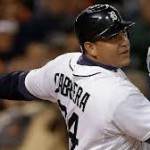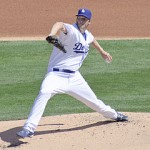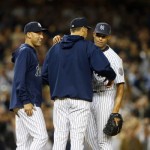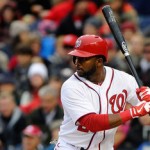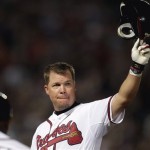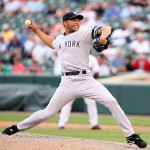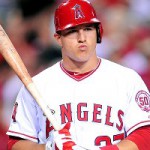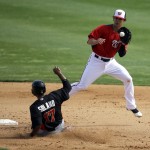
Walter’s hot start to the spring has him in a lot of people’s thoughts… Photo unk via wp.com
Well, the entire DC area was off-work with yesterday’s (hopefully) final snowfall of the season snarling roads and cancelling work. But Tom Boswell was busy chatting. Here’s how i’d have answered his baseball-related questions from his WP chat session on 3/3/14.
Q: Walters is 5-5 and making some impressive defensive plays. Do you foresee him being more than a September call up this year – perhaps a quality utility player? He also seems like a sharp kid and an interesting character.
A: Well, the only “impressive play” I’ve seen Zach Walters pull off was a 2-run scoring throwing error … but that’s just a “short sample size.” To answer this question; yes I think Walters is more than a 9/1 call up this year; I think he’s going to be the first guy called up (ahead of both Jamie Carroll and/or Mike Fontenot at this point) if we need middle infield coverage. I’m worried about his defense (as has been noted in this space before), so I dunno how much we want to depend on him … but so far he’s looking impressive indeed at the plate. What more does he have to prove in AAA? The more he hits, the more he pressures the organization to give him a shot at the MLB level. Boswell doesn’t know either; there’s no room at the inn for him here; maybe a trade is in order to either move him or free up space for him.
Q: If Danny Espinosa can find his swing and cut down on the strikeouts, could Matt Williams get 300+ ABs for him alternating between 2nd/SS/3rd as a super utility?
A: I’m pretty sure that’s the plan for him even if he doesn’t necessarily “find his swing” right now. Who would you rather go to war with as your backup infielder right now? Danny Espinosa or a 40-yr old punch-less middle infielder like Carrol or Fontenot? More and more I think the decision may be Espinosa vs Walters. Boswell agrees, thinking Espinosa *is* going to be the primary utility guy for this team.
Q: Does Mussina get in to HOF?
A: Hmm. That is a tough one. On the one hand his career bWAR is *way* up there (82.7, which puts him in some very heady company right around 50th best in the history of the game). JAWS likes him, and the “Hall of Fame Standards” metric on B-R.com thinks he’s borderline. On the other hand his ERA isn’t fantastic (career 3.68, career ERA+ of 123, which is about what Jimmy Key or Tim Hudson are pitching to for their careers). Didn’t get the magical 300 wins or 3,000 strikeouts. Never won a Cy Young but was in the top 6 in voting 9 times out of 18 years. Five all-star appearances, seven gold gloves. 7-8 with a 3.42 ERA in 139 2/3 post season innings, where he peaked in his 1997 exploits in an epic Baltimore vs Cleveland series. I think he was unquestionably one of the best arms in the game for a period of time, even if Cy Young’s don’t show it. He did not have the greatest reputation with the media though.
Answer? I’d vote for him, but i’m a “bigger hall” guy. I think he’s the type who gets in after a few votes to gather steam as people remember how good he was. But I think its also telling that his best player comparable on B-R is Andy Pettitte, another very borderline hall-of-fame guy. There’s certainly no PED usage issues with Mussina; maybe that’s enough to get him votes that other players will never get. Boswell agrees with my sentiments here.
Q: What are the Syracuse Chiefs expecting in terms of a pitching staff this year?
A: In December 2013, here’s what I predicted for Syracuse’s pitching staff:
- AAA Rotation: Jordan, Karns, Rosenbaum (L), Young, MLFA or two?
- AAA Bullpen: Barrett, Mattheus, Garcia, Davis, Cedeno (L), Robertson (L), Herron (AA?), Alfaro, Stange, Delcarmen
- AAA Release candidates: Meyers, Lehman
What’s happened since then? We traded away Karns, resigned Ryan Tatusko, resigned Tyler Robinson, signed Clay Hensley , signed a lefty Zack Jackson, signed a righty Warner Madrigal, signed former Nat Luis Ayala, traded for Felipe Rivero, signed Josh Roenicke and (just today) signed another former Nat Reliever Michael Gonzalez.
Phew. That’s a lot of guys signed who all look like they belong in AAA. I honestly have no idea how spring training is going to shake out but I do see one issue here: none of these new guys coming in are starters. So with Karns traded away, we’re looking at just 3-4 true starters left out of all these guys. Does Tatusko go back into the rotation? Do the Nats throw a bone to one of the remaining veteran FA starters out there (Joe Saunders has local connections, and Barry Zito could use some work).
If I had to guess, right now, what 5 starters and 7-8 relievers break camp and fly to upstate NY i’d go with the following:
- AAA Rotation: Jordan, Rosenbaum, Young, Myers, Tatusko
- AAA Bullpen: Barrett (closer), Davis, Cedeno (L), Robertson (L), Ayala, Gonzalez, Rivero (L), Delcarmen.
- AAA D/L: Mattheus, Garcia (come on, you know its going to happen)
As for the rest of these guys? Maybe some push back to AA, maybe the rest exercise out clauses and hit MLFA again. But there definitely seems like a ton of 4-A/AAA guys for not a lot of spots. Boswell has no idea and openly solicits input from people who do follow the Nats minors.
Q: Why is the opener in Australia a real game instead of an Exhibition?
A: Probably because the moment it becomes an exhibition thousands of miles away … teams would basically send their AAA squads. And MLB knows it, so they have to be “real games.” Boswell just notes how unfair it is to the teams that play.
Q: What’s the best way to get Bryce Harper’s autograph on a special piece of memorabilia?
A: Probably to go to Spring Training and bring along a little kid  That’s my plan, eventually, to use Son-as-proxy to get cool autographs. Of course, I also have this thing where everytime i’m in a position to get an autograph I have the player customize it to my son … cheesy, sure. But i’m not acquiring autographs to re-sell them or some fool thing. Boswell doens’t have any good advice.
That’s my plan, eventually, to use Son-as-proxy to get cool autographs. Of course, I also have this thing where everytime i’m in a position to get an autograph I have the player customize it to my son … cheesy, sure. But i’m not acquiring autographs to re-sell them or some fool thing. Boswell doens’t have any good advice.
Q: Assuming you could afford them all and they would resign, if you had to who on the current roster to make “lifelong” Nats – who would you choose among Desmond/Zimmermann/Strasburg/Harper? And who is the most replaceable?
A: Great question. The kind that will inevitably lead to 30+ comments here 
Assuming money is no object and that they’d all re-sign, I think your “lifelong” Nats have to be in order Desmond, Harper, Strasburg, and then Zimmermann. All four if you can get them. I think they’re replaceable in this order: Zimmermann, Strasburg, Desmond and Harper. But even that order is splitting hairs between Strasburg and Desmond; who is more replaceable? A top-5 short stop in the league or a top-10 arm? I dunno. Harper is in a league by himself; you just can’t replicate power hitters who matriculate to the majors by age 19.
I think Zimmermann is the most replaceable by our pipeline of upper-end arms. The other three guys, not so much.
By the way, this question goes to the essence of my arguments against “Big Money GMs” as postulated in the post and comments sections of my big GM Rankings post last week. This question is entirely moot if you have a $200M payroll. Do you think Brian Cashman ever had to sit down with his ownership and go, “ok we’ve got Derek Jeter, Mariano Rivera, Bernie Williams and Jorge Posada coming up on the end of their deals: we can only keep a couple of them; which ones are we letting walk?”
Boswell goes slightly different order of replaceability, putting Strasburg ahead of Desmond because the Nats have Espinosa and Walters. Uh … not sure I think either of those two guys is a “replacement” for Desmond right now Mr. Boswell. Nonetheless he also postulates that the Nats really can only keep two of the four, and that internally they keep a “5 max contract” limit in place, meaning that they still have some flexibility to keep three of these four guys.
Q: I am not impressed with the Nats’ bench, because it is a bucket full of strikeouts. Does this open a door for Jamey Carroll to make the Opening Day roster? Would it be a bad sign if he did?
A: I cut-n-pasted this whole question because I love the “bucket-full of strikeouts” line. Maybe a grizzled vet keeps Carroll instead of Espinosa or Tyler Moore. Maybe not. But if you carry Carroll instead of Moore, you are trading one commodity (defense) for another (power). I’d rather have Moore but understand the positional flexibility of Carroll. Boswell seems to intimate the decision will be Carroll vs Walters: why does everyone assume Moore is making this team with two other backup outfielders already under multi-million dollar contracts??
Q: If Zach Walters continues his excellent play from the end of last year deep into the Spring, and Danny Espinosa parties like it’s 2012, do you see the Nats dealing Espinosa this year, or are his defensive skills at short and second too valuable to lose?
A: Yes, I think Espinosa will eventually be traded, as I’ve noted many times here (best summarized in this 1/2/14 Ladson inbox response). But, he has to regain value first. If he’s suddenly returning to a near 100 ops+ hitter with his defensive prowness, there’s a whole slew of teams that could use an upgrade at the position (just perusing RotoWorld depth charts, I can see a 2011-esque Espinosa being a desirable choice to current options for at least Houston, Minnesota, Miami, maybe the Mets, Pittsburgh, San Diego, maybe Chicago (WS), maybe the Angels, maybe Seattle, and maybe the Dodgers (so they can move Hanley Ramirez back to 3B). And that doesn’t even look at the 2B options out there that he could ably fill. Boswell notes this little nugget; the Dodgers sniffed around on Espinosa exactly to do what I just said; move Hanley back to third.
Q: Should we be concerned about middle infield depth? If Espinosa can’t hit over .200, who’s left? Jamey Carroll’s OBP was .267 in 227 ABs last season… yikes.
A: I’m not concerned because we should only have to count on one of these guys. Espinosa (as mentioned ad naseum) had a pretty legitimate excuse for his BA last year; he was hurt. He’s healthy now; there should be no reason he doesn’t return to at least a .240 guy with power he was for his first couple of seasons. Boswell points at his new favorite fan boy Zach Walters.
Q: Assuming the Nats fifth starter (whoever it may be though I’m pulling for Detwiler) has a great “fifth starter” season, how good can we expect it to be? Has any fifth starter won 15-20 games?
A: I think a “good” season out of our 5th starter would be 28 starts, a 14-8 record or something like that, and an ERA in the 3.50 range. I’d love to see that happen. Has a 5th starter ever won 15-20 games? I have no idea how you’d find that out; it isn’t as if starters are “labeled” by their rotational rankings like we do in the sportswriting world. I looked up a couple of options though to see how some “5th” starters fared on some very good teams (looking up the winningest teams I could think of in the 5th starter era)
- The 5th starter for the 108 win 1986 Mets was Rick Aguilera; he went 10-7 with a 3.66 ERA.
- The 114-game winning 1998 Yankees 5th starter was Orlando “El Duque” Hernandez, who went 12-4 and had the best ERA+ on the staff, but he wasn’t exactly a “normal” 5th starter. In reality by the time the playoffs rolled around the real 5th starter was Hideki Irabu: he was 13-9 in the regular season but didn’t get a start in the post-season.
- Lastly the 116-game winning 2001 Mariners’ 5th starter seemed to be John Halama, who went 10-7 despite a 4.73 ERA and was replaced mid-season by rookie Joel Pineiro.
Boswell notes a good point; if a “5th starter” wins 20 games … people forget he was the 5th starter.
Q: He had 38 (or thereabouts) errors in Syracuse this year. I don’t think there should be any serious talk of him spending significant time with the Nats until he can clean up his fielding in AAA.
A: I wonder if the person who sent in this question also reads me. By the way: the break down of Errors (per b-r.com) was 31 errors in 104 games at short to go along with 7 additional errors in 27 games while playing third. That’s a LOT of errors. And it is almost entirely consistent with the number of errors he committed in 2012 in AA. So this wasn’t a fluke season.
We all hear stories about how crummy minor league fields are and how they contribute to poor fielding numbers for players. Have you ever played on a pro field? They’re miles better than any amateur field and looked beyond immaculate to me. I wonder just how much nicer they can get honestly.
But, yes I do somewhat agree with the questioner here; I’d like to see Walters have a cleaner fielding season before counting on him. That being said, we should all remember that we were ready to string up Ian Desmond for his fielding issues … now he’s a gold-glove calibre talent. Boswell brings up Desmond’s incredibly poor minor league fielding record … maybe there’s more truth to the whole minor league field issue than we thought.
Q: Do you think Storen might not be long for the team? I’ve felt for some time that Game 5 in 2012 truly affected how Rizzo sees him. Also, many like to say they have three guys who have closed in the bullpen. I feel the 7th, 8th and 9th are all different so that theory doesn’t always work. Thoughts?
A: I’m not sure if 2012 has anything to do with it: Drew Storen definitely got squeezed in that inning and in some ways was very unlucky. And as my dad likes to point out, Davey Johnson‘s usage of Storen in the series (and his bullpen management overall) really left something to be desired. Nonetheless, to answer the question no I think Storen is eventually moved, not because of any bad blood but because of simple economics. We’ve got a really expensive bullpen and three closer-quality guys when only one is needed. At some point we will cash in. I’m not sure I believe that 7th/8th/9th innings require different mindsets; you still want guys who can get people out, you want swing-and-miss talents, you want people who can keep the ball in the park and not walk anyone. Boswell doesn’t really answer the question.


